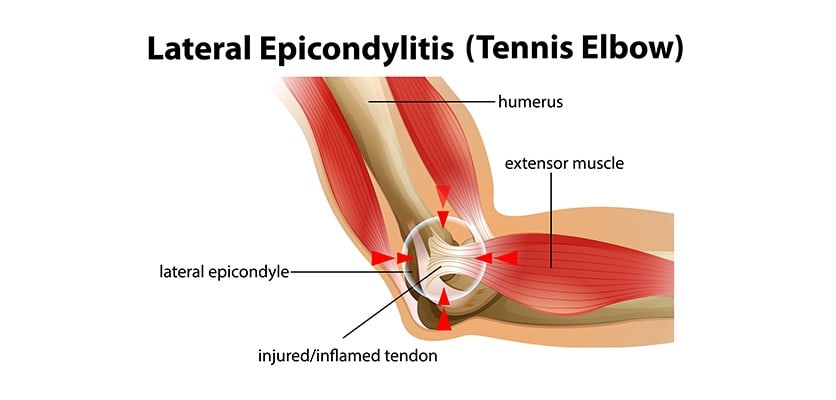Almost everyone has felt that sore, aching arm after a heated match on the court—whether it’s tennis, badminton, or the latest obsession sweeping through Malaysia: pickleball and paddleball. That lingering elbow discomfort might seem like no big deal at first, but what if it sticks around? What if gripping your paddle, lifting your grocery bag, or even turning a doorknob starts to send a jolt of pain through your arm? You could be dealing with tennis elbow. Despite the name, this condition isn’t reserved for Wimbledon hopefuls—it can affect anyone who repeatedly uses their arm and wrist in similar motion. And with more Malaysians picking up paddle sports for fun and fitness, we’re seeing a noticeable rise in upper limb injuries, with tennis elbow topping the list.
What is tennis elbow?
Tennis elbow, known medically as Lateral Epicondylitis (LE), is a condition that causes pain and tenderness around the tendon known as common extensor tendon, which is located at the outer part of the elbow. Initially described as ‘Lawn Tennis Arm’, this popular term suggests that it is often associated with tennis players, but this condition also affects others who do repetitive movements of their arm.
It’s estimated that one to three percent of adults experience tennis elbow each year, most commonly in their dominant arm. The condition tends to appear in people in their 40s and 50s, affecting men and women equally.

How does it develop?
Tennis elbow is generally regarded as an overuse injury. Anatomically, the muscles responsible for straightening the elbow are known as extensor muscles and they are attached to the outer part of the elbow by the common extensor tendon.
Extensor muscle overuse injury is typically brought on by excessive, rapid, repetitive motions of the wrist and forearm. The fast contraction of these muscles causes micro-damages in the tendon, which leads to pain and inflammation in the area. Other than overuse injury, tennis elbow can also be presented as an acute injury (injury that occurs suddenly) due to trauma to the outer part of the elbow, known as lateral epicondyle. Damage to this area can cause severe elbow pain that increases with repetitive twisting and movements of the hand, wrist, and forearm. Up to 50 percent of tennis players develop symptoms due to poor swing techniques and this condition is also seen in laborers who utilize heavy tools and equipment or engage in repetitive gripping or lifting tasks.
Tennis elbow can make simple activities like shaking hands, turning a doorknob, or even holding a coffee cup become difficult due to pain.
Who is at risk?
Does this condition only exclusively affect athletes, in particular racket sports players? Looking into the mechanism of occurrence, tennis elbow is caused by excessive overload of the elbow joint after playing a sport or due to the type of profession, which leads to repeated injuries to the soft tissue around the area.
Athletes who perform repetitive movements are at a higher risk of developing this condition. Young tennis players who have not learned the exact technique of playing the game are also more likely to develop tennis elbow. There have also been documented cases where a short burst of high-intensity activity in sport leads to painful elbow conditions. For example, sudden lifting of a heavy dumbbell or forceful throwing of a ball in handball can suddenly cause pain in the lateral elbow region.
It’s also surprisingly common as an occupational injury. People who do repetitive tasks—like construction workers, mechanics, and even surgeons—often develop it over time. But here’s the twist: even desk-bound professionals aren’t immune. IT workers, accountants, and anyone who spends long hours typing, clicking a mouse, or using their wrists in repetitive ways can also fall victim. That constant strain on the forearm muscles might not seem like much day-to-day, but over time, it adds up. And while modern appliances like washing machines, dryers, microwaves, and air fryers have taken some load off homemakers, back in the day, housework involved a lot more scrubbing, wringing, and manual labour—which also made tennis elbow a familiar foe in many households.
Other Common Sports Injuries
Tennis elbow isn’t the only issue that racket sports lovers might face. Other common conditions include:
- Golfer’s elbow – Similar to tennis elbow but affecting the inner side of the elbow.
- De Quervain’s tenosynovitis and intersection syndrome in the wrist – Painful wrist conditions caused by repetitive wrist and thumb movements, but they affect different tendon areas.
- Rotator cuff injuries – Shoulder pain from repetitive overhead motions.
- Labral tears and acromioclavicular joint pain – Shoulder injuries that can be caused by repetitive overhead or swinging motions
How to treat tennis elbow?
The good news is that tennis elbow is a self-limiting condition, meaning it often heals on its own with proper care and can be well-managed with conservative management (non-invasive procedures).
The mainstay of treatment is mainly control of pain, preservation of movement, improvement of grip strength and endurance, and return to normal function.
Multiple conservative treatments have been developed for the management of tennis elbow, including stretching, deep massages, non-steroidal anti-inflammatory drugs (NSAIDs), bracing, thermal therapy, transcutaneous electrical nerve stimulation (TENS), and extracorporeal shock-wave therapy (ECSW). Local injections of analgesics (medications to relieve pain) and steroids (anti-inflammatory medicines) have also been administered concurrently to help alleviate the pain in patients who show slow, or delayed progress in pain management. There have been studies to prove that patients who attend physical therapy show better outcomes in pain management as compared to those who don’t.
Recent studies have also examined and supported the use of the counterforce brace and Kinesio taping for the treatment of tennis elbow. However, the combination of physical therapy in combination of these modalities have shown superior results as compared to isolated taping or bracing.
Finally for those patients who still suffer pain due to tennis elbow despite the conservative management, the option of surgery can be considered.
How soon can patients return to playing sports? Any prevention tips?
Stressing that tennis elbow is a self-limited illness is the most important part of treating the condition. Once the initial discomfort has been relieved, it could be advised for patients to slowly return to play as soon as their symptoms allow. Patients are advised that discomfort is common, especially after just an exercise session, and that they can resume their sporting activities as long as the discomfort is below a bearable level and there are no symptoms of instability.
Tennis elbow can prove to be a challenging condition to treat, and it frustrates the patient when he or she is not able to return to play and enjoy the game. It is always advisable to do adequate stretching and strengthening exercises of the forearm and shoulder to prevent this and other injuries. Adequate rest in between game days proves useful to patients who are from the senior age group. Young athletes picking up the game should learn the right way to play the sport. Good techniques and proper biomechanics go a long way in the prevention of injury and performance enhancement. Those who exhibit symptoms are advised to seek medical advice early to prevent chronic pain and retirement from racket sports.
This article first appeared in TheRakyatPost, 23 May 2025.
Share:
Was this article helpful?
Share:
Was this article helpful?
Health Packages
Elevate your health with tailored health packages at Columbia Asia Hospital. Take charge of your health journey today.
Pink October 2024
From
RM80
Pink October 2025
From
RM80
HLA Policyholders Promo: Influenza Vaccination
RM65
Find Out More
